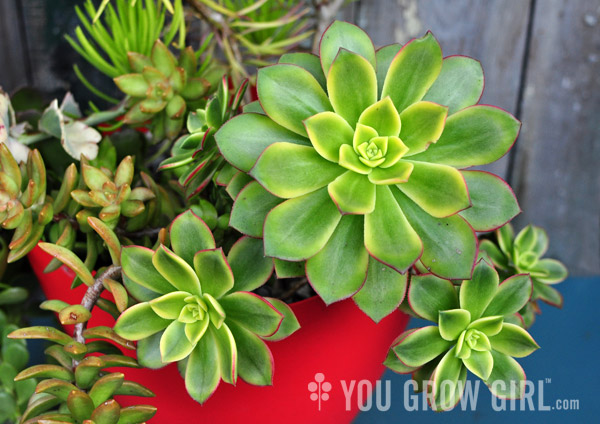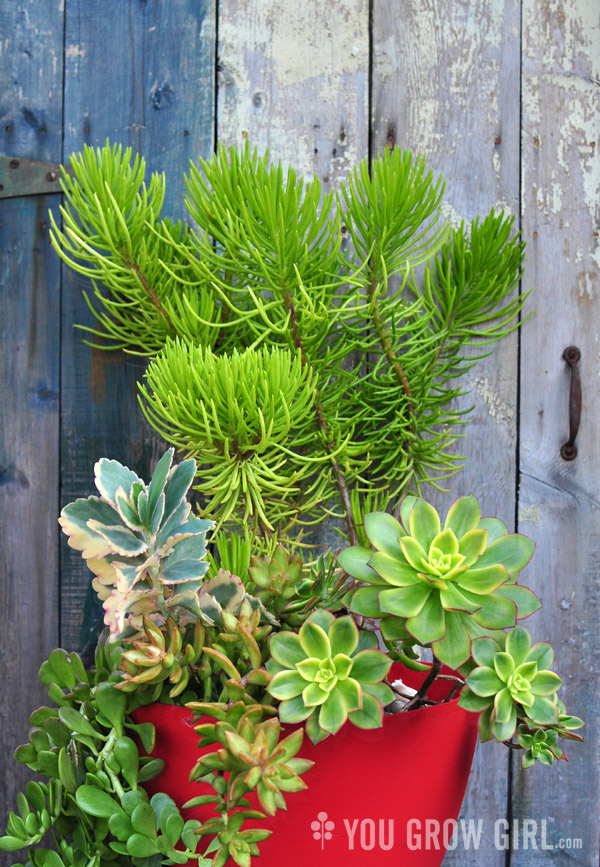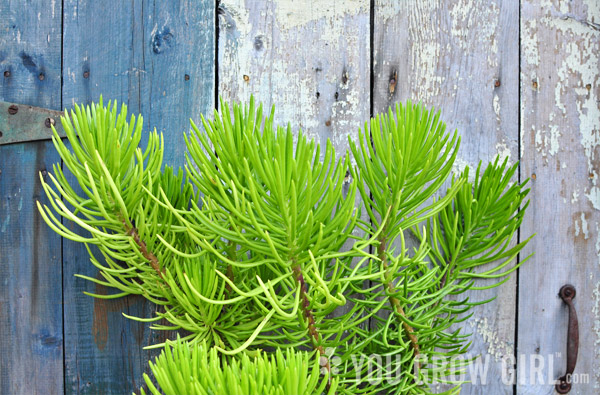
I went all out for succulents this year and had some fun putting together a range of containers using tender plants. I live in a colder climate where tender succulents must be brought inside to overwinter, and for this reason I have tended to stick to making mixed plantings of hardy succulents only (with the exception of echeveria). While I grow many tender succulents, I often relegate them to one plant per pot to make shifting them between the outdoors and in an easy task. But not this year. This year I let my succulent love flourish!
The following photos are of one of the mixed succulent containers I planted this year.
I purchased the large, bright red, plastic pots at Target this past spring (I tried but am unable to locate them on the website). I also bought a couple of self-watering hanging baskets in the same red. One is hanging in my office and holds a very large opuntia (I posted a quick shot of it over here) and I used the other to grow a petite currant tomato variety called ‘Sweet Pea.’ Please note that the latter was an experiment to help me gauge how far I can push that particular plant variety. The pots are categorized as #5 Polypropylene, which is considered “safer,” but my advice regarding plastics for growing food crops is to use common sense and err on the side of caution.

From Left to Right: Senecio jacobsenii (thanks go to Uli who identified this plant.), Kalanchoe fedtchenkoi ‘Aurora Borealis’ (the variegated plant), Sedum nussbaumerianum, Aeonium ‘Kiwi’ variegated plant on right).
Tall Plant in Back: Senecio cylindricus

Close up on the Senecio cylindricus.
Gorgeous!!
We are getting close to a frost here and I am making space inside to bring all “tenders” in for protection. My Aeoniums are the dark purple kind and were very happy outside all summer. I also have a common Jade and a variegated Jade, plus the Bay Tree, Oxalis Purple Shamrocks, two XL figs and two small mixed planters of Echeveria and other silvery, strangely-shaped tender succulents.
I wish the plant folks at the stores would take time to get succulents labeled. I would love to know what they are before I buy them. They must think we aren’t interested, or that we’ll buy them anyway so why take the time to label. (Probably true)
I don’t recognize the trailing succulent in your planter, but it resembles my common Jade plant except it’s going downward. Maybe that makes it a Crassula member? It all goes together so nicely. Even the weathered wood backdrop is attractive.
I also think it is a crassula but I haven’t been able to find it in any of my books. The mislabelling or lack-of when it comes to succulents is a huge problem. I go to great lengths to try and identify mine as nearly 90 percent of them aren’t labelled or have a tag that just says “Succulent.”
i’ve been having the hardest time finding decent indoor hanging planters. where did you find that red one?
The red hanging basket is the same line from Target as the red planter I used for the succulents seen in the above photos. The line is called RE: Room Essentials. I tried searching for it on the Target site but not luck. You’ll have to go to a store and look in the garden section. I bought these in a new Canadian Target, but saw them again in Phoenix, Arizona when I went to a Target there so I assume they’re in all North American stores.
I bought the hanging baskets because I NEVER see aesthetically pleasing and PRACTICAL hanging baskets that can be used indoors. It’s pretty good and has a little watering hole in the bottom piece so you can water from below.
Amazing how many Crassula’s there are to evaluate. Here’s one that seems similar to your Crassula, although it looks too grey in the photo. Leaf designs are probably the disqualifier.
http://gosucculent.com/store2/succulents/crassula-volkensii/
“This little succulent will grow into a small vine-like low growing shrub. Intricate details on the leaves and tiny white flowers. Native to eastern africa,kenya,tanzania.”
This same site has your Propeller Plant in flower:
http://gosucculent.com/store2/succulents/crassula-perfoliata-v.-falcata/
Oh yes, there is an exceptional number of species and varieties in all of the succulent genera. This is why identifying can be a nightmare. It took me a few hours of searching through my personal collection of succulent-related books and then cross-referencing online to feel confident in the identifications I made for this post. And I still couldn’t properly identify that trailing crassula! It just doesn’t show up anywhere.
Incidentally, I posted about Propeller Plant yesterday! Definitely not the same plant. https://www.yougrowgirl.com/succulent-fever-propeller-plant/
The other issue that comes up when identifying succulents is that they can experience colour shifts based on the amount of sun, cold, and drought they experience (of course photos can also be poorly colour-corrected and inaccurate). For that reason the lack of grey isn’t an issue. It may well be a silvery grey when grown in brighter sun.
I am starting to consider the possibility of Crassula obvallata but only have one image to go on right now (in the book “Succulents: The Illustrated Dictionary”). I like to cross-reference multiple sources before feeling confident.
Have you considered Senecio jacobsenii aka Kleinia petraea as your trailer?
Uli
Yes! I think you’re right! I never would have guessed that it could be an senecio. Thanks so much Uli
We have bought and inherited LOTS of cacti and sedums. Love to mix them in containers but I’ve had to move some to their own home pots because of their size. Love the combination you chose. Beautiful.
The succulents looks so healthy! What a wonderful presentation it must be for you and your house hold. :-)
Beautiful!